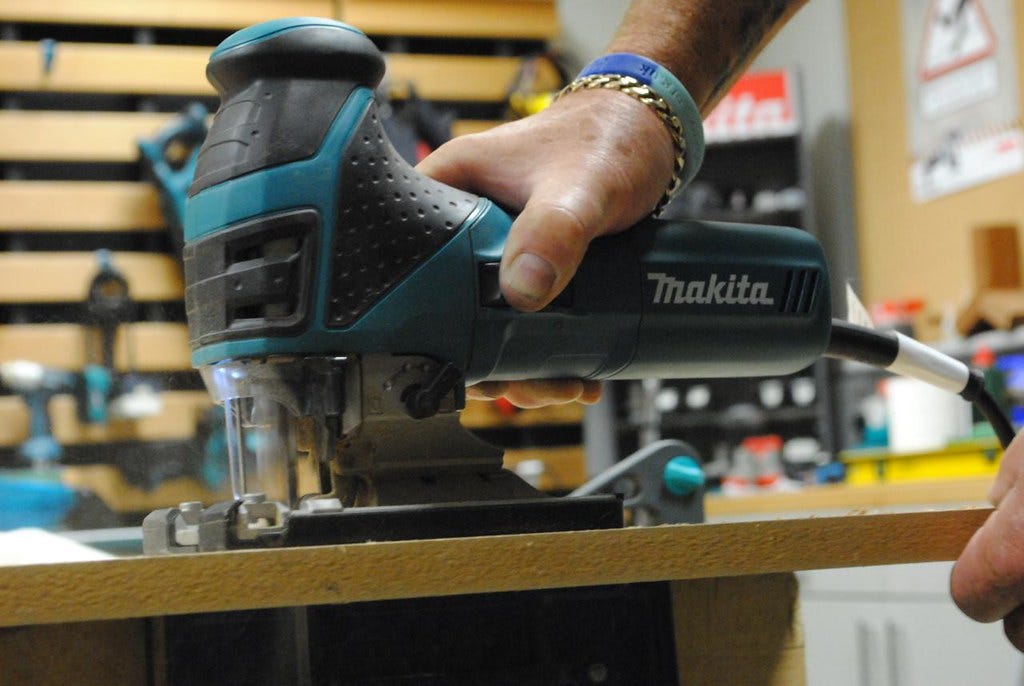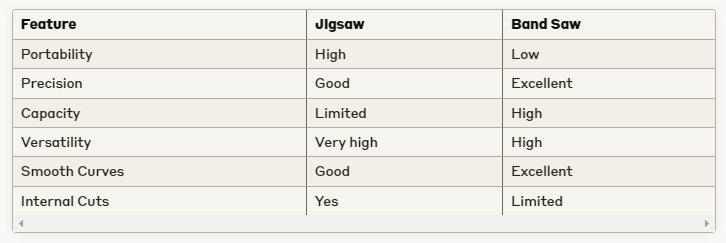Mastering Curves and Details: Jigsaw vs Band Saw
When it comes to creating smooth curves and intricate details in woodworking projects, two tools stand out: the jigsaw and the band saw.
Jigsaw: The Master of Details
What is a Jigsaw?
A jigsaw is a portable power tool that uses a reciprocating blade to make cuts. Its versatility makes it ideal for curved cuts, internal cutouts, and detailed work in wood.
Advantages of the Jigsaw:
Portability: Easy to handle and transport.
Versatility: Capable of making straight, curved, and angled cuts.
Precision in Details: Excellent for intricate work.
Internal Cuts: Allows starting cuts in the middle of a piece.
Tips for Using a Jigsaw:
Blade Selection: Use specific blades for each type of material.
Appropriate Speed: Adjust the speed according to the hardness of the wood.
Cutting Guide: Use a guide for more precise cuts.
Cutting Technique: Let the saw do the work, don't force the blade.
Jigsaw Maintenance:
Clean regularly to remove sawdust and debris.
Check and replace carbon brushes when necessary.
Keep blades sharp and replace them when worn.
Band Saw: The Queen of Curves
What is a Band Saw?
A band saw is a stationary machine that uses a continuous loop blade to make cuts. It's ideal for long and curved cuts in larger pieces of wood.
Advantages of the Band Saw:
Long and Smooth Cuts: Perfect for wide and continuous curves.
Cutting Capacity: Can easily cut thicker pieces.
Stability: Provides more stable and precise cuts.
Versatility: Useful for resawing wood and making angled cuts.
Tips for Using a Band Saw:
Blade Tension: Keep the blade properly tensioned.
Blade Guides: Adjust the guides correctly for a precise cut.
Feed Rate: Feed the wood steadily and smoothly.
Safety: Always use push sticks when working with small pieces.
Band Saw Maintenance:
Clean the wheels and blade after each use.
Check wheel alignment regularly.
Lubricate moving parts as recommended by the manufacturer.
Comparison: Jigsaw vs Band Saw
Choosing the Right Saw for Your Project
Use a Jigsaw for:
Small and medium projects
Detailed and intricate work
Internal cuts and cutouts
Projects requiring portability
Use a Band Saw for:
Larger projects
Long and curved cuts in thick wood
Resawing wood
Work requiring high precision and stability
Advanced Techniques
Jigsaw:
Plunge Cutting: Perfect for making openings in the middle of a piece.
Bevel Cutting: Use the adjustable base for bevel cuts.
Pendulum Technique: Activate the pendulum motion for faster cuts in soft wood.
Band Saw:
Veneer Cutting: Use a thin blade to cut veneers without waste.
Circle Cutting: Use a circular jig for perfect circle cuts.
Resawing: Transform thick boards into thinner pieces with precision.
Safety First
Always wear safety glasses and ear protection.
Keep hands away from the cutting area.
Disconnect tools when changing blades or making adjustments.
Use dust masks when working with woods that produce fine sawdust.
Conclusion
Both the jigsaw and the band saw are essential tools for any woodworker looking to master the art of creating curves and details in their projects. Each has its unique strengths, and the choice between them will depend on the specific needs of each project.
With practice and the right techniques, you'll be able to create wooden masterpieces that combine precision and creativity.
Want to deepen your knowledge about saws and advanced woodworking techniques even further? Click here to access our complete woodworking course and take your skills to the next level!



